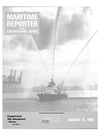
Page 18: of Maritime Reporter Magazine (January 15, 1985)
Read this page in Pdf, Flash or Html5 edition of January 15, 1985 Maritime Reporter Magazine
Computerized Vessel
Management —Nav-Com (continued from page 19)
The BUSISHIP work station can be integrated with the vessel's sat- com terminal through Nav-Com's
COMNET system to provide a di- rect interactive link with the home office computer. Built around a cen- tral electronic switching system,
COMNET can be configured with as many internal extensions and outside trunk lines as necessary.
Nav-Com states that its unique auto-access feature is an industry first, permitting all calls in either ship-to-shore or shore-to-ship direc- tion to be routed automatically through the satcom terminal with- out operator assistance.
Circle 72 on Reader Service Card
OCEAN MOTIONS
COMPANY
Ocean Motions Company of Bar- rington, R.I. has just completed de- livery of another of its SHIP LOAD-
ING COMPUTER packages to
SOHIO Cleveland.
The package includes a desk top microcomputer and printer/plotter.
Custom programs for each ship are provided on disks running between $2-4,000 depending on vessel com- plexity.
Six pre-programmed loading con- ditions are provided for the user to select and modify until he has achieved the desired draft, stability margins and compliance with ABS shear and bending allowables.
Ocean Motions has experience covering some 280 ships worldwide and offers loading calculations for each ship in their intact, damaged and grounded conditions.
Knowing the times of high/low tide and the tidal range for a stranded ship allows the master and operations superintendent to pre- dict whether the ship will retain positive stability and low hull girder stress levels. When the ship runs aground the computer calculates the position of ground contact on the hull and advises the master where to inspect for damage and flooding. Ocean Motions supplies traditional trim, stability and strength packages for all vessels in- cluding RO/RO, containerships, reefers, heavy lift ships, offshore supply ships, chemical carriers, bulkers, tankers, passenger and car ferries and all military vessels. Soft- ware comes in dedicated hardware or as fully documented disks of the
IBM-PC.
Circle 74 on Reader Service Card
PACIFIC-GULF MARINE
Pacific-Gulf Marine has develop- ed a shipboard/shoreside manage- ment system for preventive mainte- nance, machinery history, inventory control, requisitioning, and pur- chasing. The system provides on- line access to a database of ship- board machinery relevant to main- tenance and spare parts informa- tion. Reports can be generated for spare parts inventory, requistioning, purchase orders, material receipts, machinery master list, machinery history, repair work order reports, preventive maintenance reminder reports, and ABS continuous survey status. The system operates on a
Hewlett Packard HP-250 minicom- puter.
Circle 73 on Reader Service Card
PUERTO RICO MARITIME
SHIPPING AUTHORITY
PRMSA has developed an Opera- tions Planning Model that forecasts container movements by equipment type and expected revenue for spec- m • \ IV, es Wtt coP°
C!a eo^' c ok \0 sTv\ce we* 50 V oo1 ,T\ence tNtANO v -GULf
THE AMERICAN WATERWAYS OPERATORS. INC.
TSSS&5
Circle 212 on Reader Service Card 20 ified port-to-port and port-to-ter- minal combinations to plan for low- er overhead and enhanced utiliza- tion of equipment. It provides short-term predictions of demand for container types and the benefits from short-notice reassignment of the container inventory according to demand. It permits users to deter- mine in advance of sailing the con- tainer assignment mix to handle the expected load. Mid-range forecasts of cargo movements are used for planning sailing schedules, opera- tional budgets, and marketing strat- egies.
Circle 75 on Reader Service Card
PUGH ROBERTS
ASSOCIATES
A strategic planning model for liner shipping has been developed with the assistance of Lykes Bros.
Steamship Company. This model contains equations that describe in detail the workings of the liner industry, including the acquisition, deployment, and scrapping of ves- sels; competition for trade among routes; types of vessels and carriers; financial flows; the managerial deci- sions of owners and operators; and the prevailing economic and regula- tory environment. It is set up to simulate the performance of liner trades from the U.S. West Coast to the Far East over the past 10 years and for 10 years into the future.
Circle 76 on Reader Service Card
RAYTHEON OCEAN
SYSTEMS
Raytheon's LOADMAX digital loading computers are used for on- board trim and stability calcula- tions. The system calculates and displays accurate draft, stability, and hull stress data for large vessels in any loading condition. It is pro- grammed according to each ship's characteristics. Special programs are available for LNG/LPG carriers, integrated tug/barge combinations and containerships.
LOADMAX is a quick, easy way to plan optimum loading for any type of ship. It rapidly calculates and displays accurate draft, hull strength and stability data for any loading condition.
LOADMAX is as simple to use as a desk calculator—tonnage distri- bution and calculated results are read at a glance.
Designed for the particular oper- ating requirements of each ship,
LOADMAX combines numeric ton- nage displays with an easily under- stood mimic diagram of the vessel. A separate graphic display shows whether the ship is in hogging or sagging condition and if shear force or bending moment limits are being exceeded.
Circle 77 on Reader Service Card
Maritime Reporter/Engineering News

 17
17

 19
19
